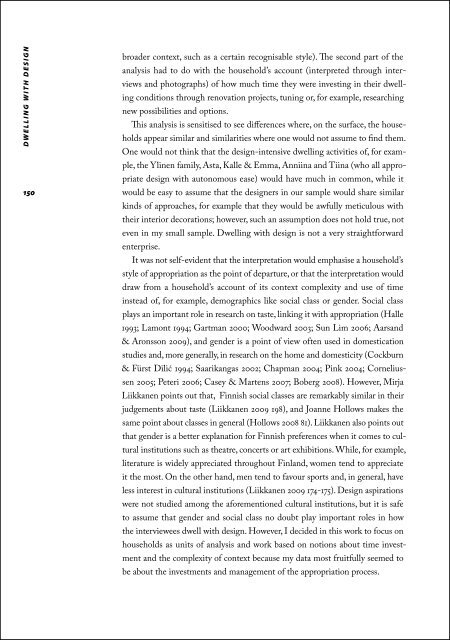Lataa ilmaiseksi
Lataa ilmaiseksi
Lataa ilmaiseksi
You also want an ePaper? Increase the reach of your titles
YUMPU automatically turns print PDFs into web optimized ePapers that Google loves.
D W E L L I N G W I T H D E S I G N<br />
150<br />
broader context, such as a certain recognisable style). The second part of the<br />
analysis had to do with the household’s account (interpreted through interviews<br />
and photographs) of how much time they were investing in their dwelling<br />
conditions through renovation projects, tuning or, for example, researching<br />
new possibilities and options.<br />
This analysis is sensitised to see differences where, on the surface, the households<br />
appear similar and similarities where one would not assume to find them.<br />
One would not think that the design-intensive dwelling activities of, for example,<br />
the Ylinen family, Asta, Kalle & Emma, Anniina and Tiina (who all appropriate<br />
design with autonomous ease) would have much in common, while it<br />
would be easy to assume that the designers in our sample would share similar<br />
kinds of approaches, for example that they would be awfully meticulous with<br />
their interior decorations; however, such an assumption does not hold true, not<br />
even in my small sample. Dwelling with design is not a very straightforward<br />
enterprise.<br />
It was not self-evident that the interpretation would emphasise a household’s<br />
style of appropriation as the point of departure, or that the interpretation would<br />
draw from a household’s account of its context complexity and use of time<br />
instead of, for example, demographics like social class or gender. Social class<br />
plays an important role in research on taste, linking it with appropriation (Halle<br />
1993; Lamont 1994; Gartman 2000; Woodward 2003; Sun Lim 2006; Aarsand<br />
& Aronsson 2009), and gender is a point of view often used in domestication<br />
studies and, more generally, in research on the home and domesticity (Cockburn<br />
& Fürst Dilić 1994; Saarikangas 2002; Chapman 2004; Pink 2004; Corneliussen<br />
2005; Peteri 2006; Casey & Martens 2007; Boberg 2008). However, Mirja<br />
Liikkanen points out that, Finnish social classes are remarkably similar in their<br />
judgements about taste (Liikkanen 2009 198), and Joanne Hollows makes the<br />
same point about classes in general (Hollows 2008 81). Liikkanen also points out<br />
that gender is a better explanation for Finnish preferences when it comes to cultural<br />
institutions such as theatre, concerts or art exhibitions. While, for example,<br />
literature is widely appreciated throughout Finland, women tend to appreciate<br />
it the most. On the other hand, men tend to favour sports and, in general, have<br />
less interest in cultural institutions (Liikkanen 2009 174-175). Design aspirations<br />
were not studied among the aforementioned cultural institutions, but it is safe<br />
to assume that gender and social class no doubt play important roles in how<br />
the interviewees dwell with design. However, I decided in this work to focus on<br />
households as units of analysis and work based on notions about time investment<br />
and the complexity of context because my data most fruitfully seemed to<br />
be about the investments and management of the appropriation process.
















